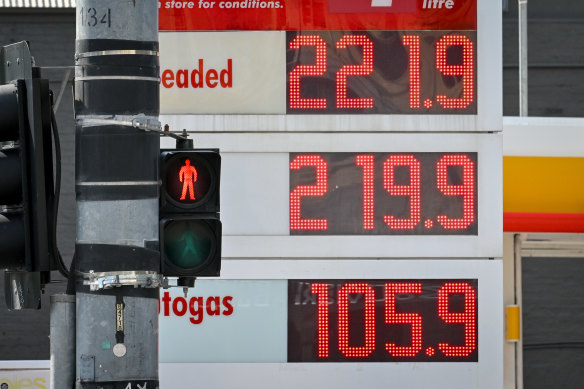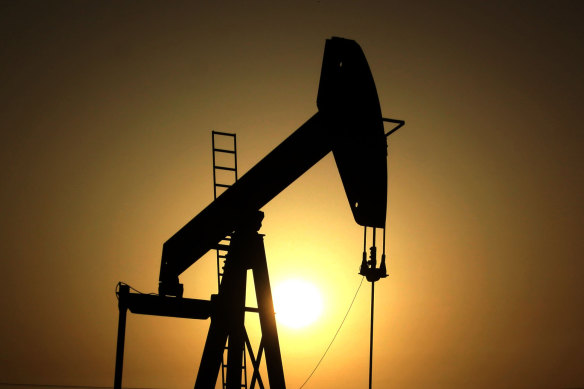- Analysis
- Business
- The economy
- Energy
This was published 5 months ago
What a Middle East oil shock could mean for Australians
By Nick Toscano
For more than a year, there’s been a nagging worry hanging over the Australian economy as it battles to tame inflation: what if the fighting in the Middle East turns into a bigger war, one that disrupts the flow of oil and drives up the prices we pay for petrol?
Few commodities affect consumers as much as oil, the natural resource used in fuels, plastics, chemicals and fertilisers. But since the Israel-Hamas conflict began and oil supplies have stayed intact, energy traders have mostly brushed off concerns about worst-case scenarios. Rather, they have given far greater attention to other powerful forces, such as softer demand in China and robust oil production rates elsewhere, which have outweighed those risks and caused prices to fall.

Petrol prices are at a two-year low, but fighting in the Middle East has increased worries about oil shocks flowing through to the bowser yet again.Credit: Eddie Jim.
For Australians dealing with the cost-of-living crunch, this has brought welcome news: cheaper prices at the bowser for petrol and diesel, both of which are refined from crude oil and now cost less to produce. Last week, the national average price of unleaded was $1.72 a litre, the lowest it’s been in two years.
“The issue in the Middle East is that these conflicts have been going on as long as I can remember, but you only have a flow-on to the oil price if oil production and supply is disrupted,” says Shane Oliver, the chief economist at AMP.
“You can have battles in Israel, Lebanon and Syria, and still no impact, apart from a nervousness when the conflict first starts.”
But a week is a long time in volatile commodity markets – long enough for nervousness to take hold once again. When Iran launched a barrage of missiles on Israel on October 1, it immediately shook market players out of a long-running complacency, analysts say, and triggered an urgent rethink on the likelihood of a threat to oil supplies in the region.
Markets are not yet panicking, as much will now depend on how Israel chooses to respond. But Iran is the world’s seventh-biggest oil producer, and with the possibility that its oil assets could be on Israel’s list of targets, investors and governments are anxious about the risk of an economic fallout in a way that they haven’t been during the hostilities so far. Last week, crude prices rose 10 per cent, their biggest weekly gain in more than a year.
“We are seeing a spike in oil prices, and that has consequences for motorists and families and communities here in Australia and right around the world,” Treasurer Jim Chalmers says.
Treasury modelling suggests a sustained 10 per cent increase in the oil price over a year would add about 0.4 of a percentage point to the inflation rate.
“We’re focused on the human costs [of the conflict],” Chalmers says, “but there are economic costs as well.”

For decades, conflicts in the oil-rich Middle East have spooked markets and weighed on the economy.Credit: AP
So far, the global benchmark Brent oil price has rallied by as much as 10 per cent to hit $US80 ($119) a barrel on Friday, while the Tapis benchmark in the Asia-Pacific has climbed to $US77. If prices continue rising, each $US20 increase for a barrel of oil could add 20¢ a litre at the pump in Australia, economists say.
While higher costs will flow through to Australia, Chalmers has issued a warning to the fuel suppliers: don’t take Australian motorists “for mugs”.
“We want to make sure that the global price is appropriately reflected in the price that people pay at the bowser,” he says.
Crude oil and taxes are the biggest determining factors in the retail price of petrol, accounting for about 83 per cent of regular unleaded and diesel, according to the National Roads and Motorists Association (NRMA). Other costs include refining, wharfage, shipping, insurance, and the profit margins for retailers and wholesalers.
However, new NRMA analysis released this week also renews concerns about other inputs that are unrelated to oil price swings, and are perhaps less easily understood, such as retailers’ pricing policies.
Worrying trends for consumers, says NRMA spokesman Peter Khoury, include the price gap between E10 and premium unleaded that has now widened to nearly 25¢ a litre, as well as lengthening petrol price cycles in Australia’s three most populous cities, which are keeping prices higher for longer, and making it more difficult for motorists to find the cheapest fuel.
Australian fuel prices go through cycles of varying durations, during which retailers progressively discount their fuel by a few cents each day to compete for market share until prices bottom out, then spike again by as much as 25¢ to 40¢ a litre.
Motorists in Sydney, Melbourne and Brisbane are subjected to the longest fuel-price cycles, which now run for up to seven weeks on average, nearly double what they were six years ago, Khoury says.
“Prices go up anywhere between two and three times faster than they fall,” he says. “So the longer price cycles in Australia’s largest cities have left Australians living there exposed to higher prices.”
This week’s renewed worries around the risk of a new Middle Eastern oil shock centre on two possible scenarios unfolding. One is an attack that could knock out some of Iran’s 3 million barrels a day of production – roughly 3 per cent of global supply. The other is if Iran were to close the Strait of Hormuz, a key gateway for crude tankers from the Persian Gulf, home to nearly a third of the world’s oil production
However, analysts note, it remains equally plausible there will be no impact on supply at all. In this scenario, prices might fall further, “possibly sharply”, says Morgan Stanley, citing weaker-than-expected demand and the possibility of more production coming to market this year.

The Strait of Hormuz is a key gateway for crude tankers from the Persian Gulf, home to nearly a third of the world’s oil production.Credit: Bloomberg
“The range of possible outcomes for the oil market has rarely been as wide as it is at the moment,” the investment bank says.
“Needless to say, this backdrop makes price forecasting particularly challenging.”
The Business Briefing newsletter delivers major stories, exclusive coverage and expert opinion. Sign up to get it every weekday morning.